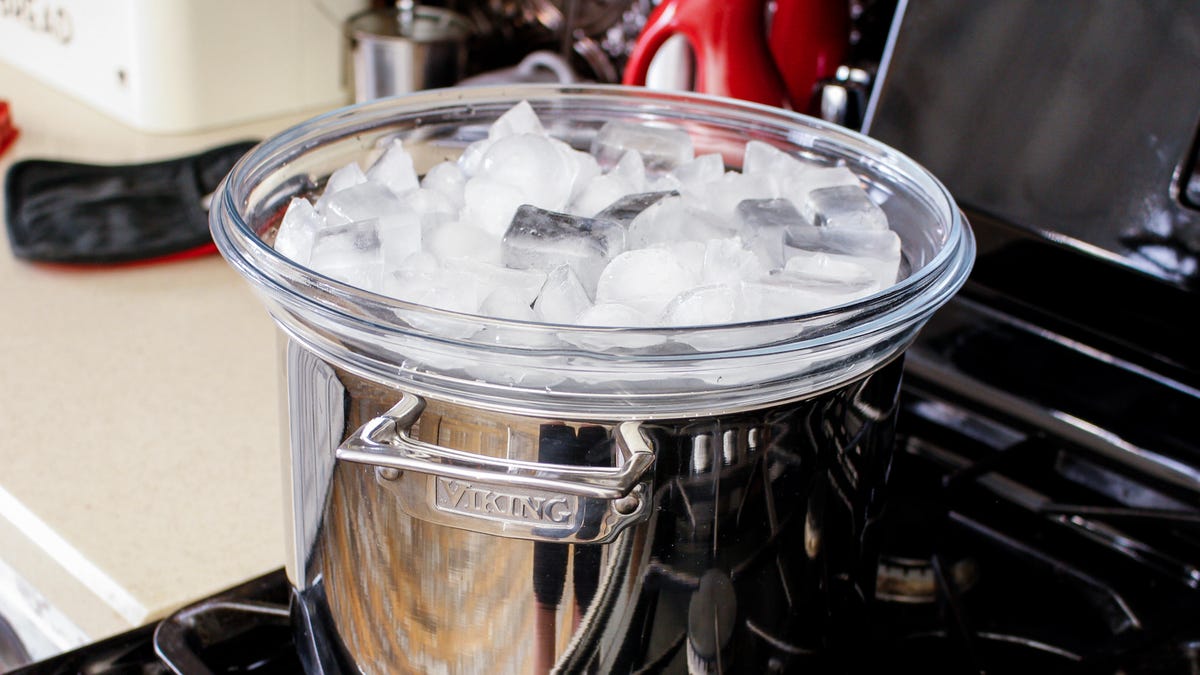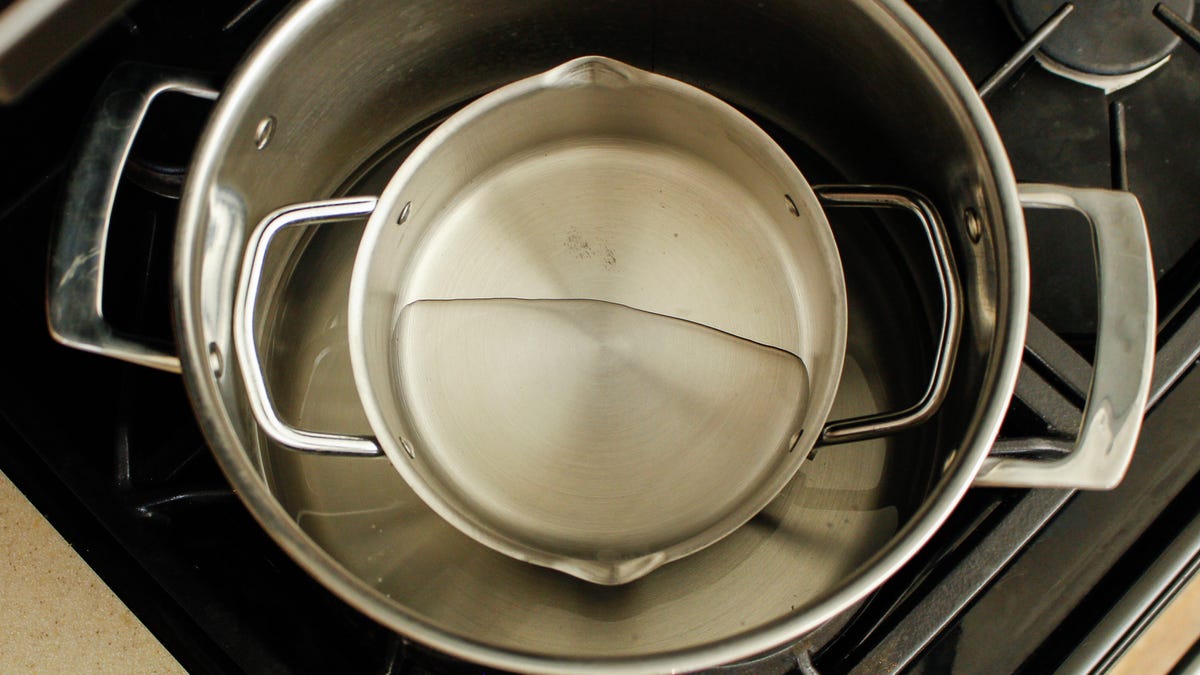Everything is Easy for the Person That Doesnt Have to Do It
This story is part of Home Tips, CNET's collection of practical advice for getting the most out of your home, inside and out.
Distilled water is the purest form of water you can find: simple hydrogen and oxygen, with 99.9% of other minerals, chemicals and pollutants removed. It's used for a variety of things in medical settings and at home. And while you can buy distilled water at the store or on Amazon, if you use it often, it helps to know how to make your own. All you need is two pots, water, a stove and a few minutes of your time. Trust me, it's a game changer.

For people suffering from sleep apnea who use CPAP machines or any other sort of humidifier, distilled water is essential. It's also useful if you don't want additional minerals in your water. (For example, distilled water won't corrode automobile engine parts or create limescale buildup in aquariums.) If you live in a place with "hard" water, or water with lots of chemicals, you can even use distilled water to protect your hair when washing it. However, since it doesn't have minerals like calcium and magnesium, distilled water tastes bland and isn't the best for drinking.
Below, I'll walk you through the five steps to make your own distilled water. I'll also go over the different types of water you may not know about and the differences between all the types of water you come across in the store. For more tips, here's whether or not its cheaper to buy groceries online compared to the grocery store, andhow to save money by making the food in your fridge last longer.
Read more: Best Water Filter Pitcher for 2022
What are the different types of water?
If you don't know the difference between tap, filtered, purified and distilled water, don't feel bad. It can be confusing.
Tap water is the easy one. Turn on your kitchen faucet. Water comes out the tap. Voila! Tap water. The quality of tap water varies by location, and might contain traces of minerals specific to the geology of your region, as well as traces of chemicals used in municipal water treatment. Hopefully your tap water is safe to drink, but that's not true for as many as 45 million Americans. Filtered water is one solution.
Filtered water starts out as plain tap water. You may already have filtered water in your home by way of a whole-house filtration system, a faucet filter or a water filtration pitcher (you can even get afiltered water bottle). Most filtered water passes through some combination of carbon and micron filters, which help to remove chemicals such as chlorine (commonly added to municipal tap water as a disinfectant) and pesticides, and metals like copper or lead. Filters can also eliminate foul odors and tastes.
Purified water usually begins as tap water as well. It will go through many purification processes, including those used for water filtration. Purified water goes a step further than filtering, with a process that removes chemical pollutants, bacteria, fungi and algae. You'll often find purified water in bottles at your local grocery.
Distilled water is a more specialized type of purified water, but much easier and cheaper to produce at home. As with purified water, it meets the classification requirement of 10ppm (parts per million of total dissolved solids, aka contaminants) or less. The process of distilling is simple: Heat tap water to the point that it turns to vapor. When the vapor condenses back to water, it leaves behind any mineral residue. The resulting condensed liquid is distilled water.
Is distilled water safe to drink?
Distilled water is completely safe for use, but the downside of distilling is that it removes all of the helpful minerals like calcium and magnesium that occur naturally in tap water. For that reason, it isn't generally recommended to use distilled water as your daily drinking water, and you may find that it lacks flavor.
You also need to choose any storage container you use for distilled water carefully. Distilled water's lack of nutrients can cause it to leach chemicals from the container it's stored in. If you plan to use the water immediately, most containers will do fine, but for long-term storage it's best to use glass or high-quality stainless steel.

How to make your own distilled water
Not to get too science-y here, but this is exciting for me. We'll be using water in all three of its known states -- solid, liquid and gas.
The gist is this: You heat water (liquid), turn it into water vapor (gas), then collect the condensation with the aid of ice (solid). It's like middle school science class all over again. You'll likely find everything you need in your kitchen. A large pot with a lid, a small pot, water, ice and oven mitts for handling the hot cookware.
It does take some time for all this science to happen, so be prepared. In my example below, I started with 8 cups of water in the large pot. After 1 hour, I had produced about 1 1/4 cup of distilled water. To recreate a gallon jug that you'd find in the supermarket you'd need about 13 hours of distilling time.
If you follow these steps, you should get near 100% yield, but whatever amount of distilled water you want to end up with, make sure to add additional water so you don't end up heating an empty pot(s) at the end of the process, which can damage cookware.

1. First, place the large pot over a stovetop burner and add 8 cups of water. Then, place the smaller pot inside the large pot. At this point, the smaller pot should float on top of the water. The key to circulating water vapor inside the large pot is airflow. Make sure there's plenty of space around the smaller pot, both around its sides and between it and the top of the larger pot.
2. Next, turn the burner to somewhere between medium and medium-high heat. I tried to keep the heat level at a steady simmer -- somewhere between 180 and 200 degrees Fahrenheit -- and not a boil. Running a higher temperature won't get you a higher yield, but it will warm up the cold side of the lid faster, and make general handling of the equipment harder to deal with.
3. After you put the burner on, place the lid upside-down on the large pot. Lids are usually higher in the middle than around the edges. Flipping the lid will allow the condensed distilled water to trickle down to the middle of the lid and into the smaller pot. Once all this is done, head over to your ice-maker (or tray) and load the top of the inverted lid with ice. The difference in temperature on the two sides of the lid will speed up the condensation process.

4. At this point, you can sit back and wait. I ended up replenishing the ice supply twice within an hour, once at 30 minutes and once after 45 minutes. This is what you need the oven mitts for -- that lid will be hot! Use caution when dumping that now-hot melted ice.

5. Any water that has dripped down into the smaller pot has now been distilled. Again, I was able to make about 1 1/4 cup of distilled water from 8 cups of tap water in about an hour.
Just remember, making your own distilled water is easy (and fun!), but lack of nutrients makes it a bad choice for daily drinking water. But if you're stuck at home and you rely on a device that requires it, or perhaps you just want to keep your fish healthy, you may want to try making it yourself.
For more, check out how toclean mold and bacteria out of your washing machine and the best way to unclog aclogged sink or aclogged toilet.
Source: https://www.cnet.com/home/kitchen-and-household/save-money-on-distilled-water-5-easy-steps-to-make-it-yourself/
0 Response to "Everything is Easy for the Person That Doesnt Have to Do It"
Post a Comment